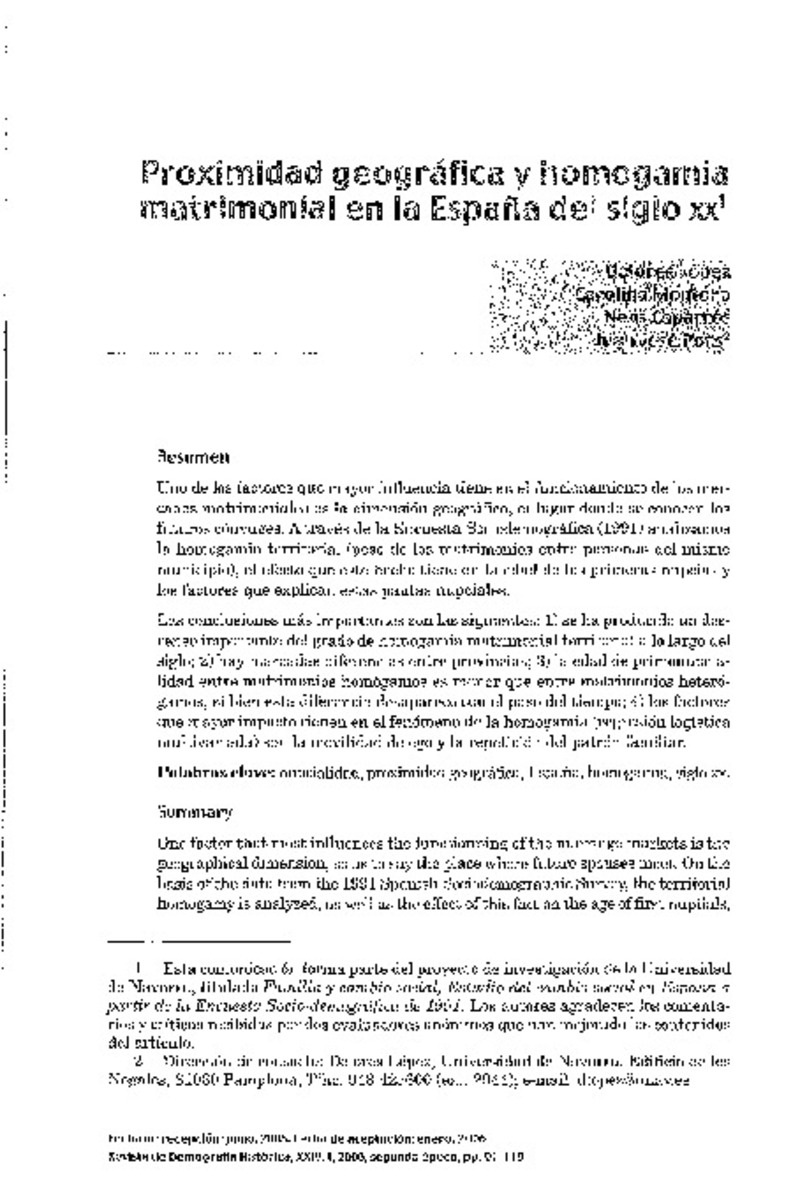Full metadata record
| DC Field | Value | Language |
|---|---|---|
| dc.creator | López-de-Heredia, D. (Dolores) | - |
| dc.creator | Montoro-Gurich, C. (Carolina) | - |
| dc.creator | Caparrós-Civera, N. (Neus) | - |
| dc.creator | Pons-Izquierdo, J.J. (Juan José) | - |
| dc.date.accessioned | 2022-02-17T11:43:03Z | - |
| dc.date.available | 2022-02-17T11:43:03Z | - |
| dc.date.issued | 2006 | - |
| dc.identifier.citation | López-de-Heredia, D. (Dolores); Montoro-Gurich, C. (Carolina); Caparrós-Civera, N. (Neus); et al. "Proximidad geográfica y homogamia matrimonial en la España del siglo XX". Revista de Demografía Histórica – Journal of Iberoamerican Population Studies. 24 (1), 2006, 91 - 120 | es |
| dc.identifier.issn | 1696-702X | - |
| dc.identifier.uri | https://hdl.handle.net/10171/62942 | - |
| dc.description.abstract | Uno de los factores que mayor influencia tiene en el funcionamiento de los mercados matrimoniales es la dimensión geográfica, el lugar donde se conocen los futuros cónyuges. A través de la Encuesta Sociodemográfica (1991) analizamos la homogamia territorial (peso de los matrimonios entre personas del mismo municipio), el efecto que este hecho tiene en la edad de las primeras nupcias y los factores que explican estas pautas nupciales. Las conclusiones más importantes son las siguientes: 1) se ha producido un descenso importante del grado de homogamia matrimonial territorial a lo largo del siglo; 2) hay marcadas diferencias entre provincias; 3) la edad de primonupcialidad entre matrimonios homógamos es menor que entre matrimonios heterógamos, si bien esta diferencia desaparece con el paso del tiempo; 4) los factores que mayor impacto tienen en el fenómeno de la homogamia (regresión logística multivariada) son la movilidad de ego y la repetición del patrón familiar. | es_ES |
| dc.description.abstract | One factor that most influences the functionning ofthe marriage markets is the geographical dimension, so as to say the place where future spouses meet. On the basis ofthe data from the 1991 Spanish Sociodemographic Survey, the territorial homogamy is analyzed, as well as the effect ofthis fact on the age offirst nuptials,and the factors that explain these marriage patterns. The following are the most important conclusions of the survey: 1) an important decline in the degree of territorial matrimonial homogamy has occurred through the 2oth century; 2) differences among provinces are shown clearly marked; 3) the age of primonuptiality between 'homogam' marriages is smaller than between 'heterogam' marriages, although this difference disappears with the passing ofthe time; 4) the factors which ha ve the most impact on the phenomenon of the homogamy (multivariate logistic regression) are ego mobility and the recurrence ofthe familiar pattern. | es_ES |
| dc.description.abstract | La dimension géographique, le lieu oU les futurs époux se sont connus, est l'un des facteurs qui influent le plus sur le fonctionnement des marchés matrimoniaux. En nous basant sur l'Enquéte Sociodémografique de 1991, nous analysons l'homogamie territoriale, c'est-<i-dire, l'effet de ce phénomene sur l'iige des premi€ res noces, ainsi que les facteurs qui expliquent ces patrons nuptiaux. Les conclusions les plus importantes tirées de cette analyse sont les suivantes: 1) une climinution importante du <legré d'homogamie matrimoniale territoriale s'est produite tout au long du xx"' siecle; 2) il y a de remarquables différences entre provinces; 3) l'iige de primonuptialité entre mariages homogames est inférieure a celle des mariages hétérogames, mais cette différence disparait avec le passage du temps; 4) la mobilité de l'ego et la répétition du patron familial sont les facteurs qui impactent le plus sur le phénomene de l'homogamie (régression logistique multivariée). | es_ES |
| dc.language.iso | spa | es_ES |
| dc.publisher | Asociación de Demografía Histórica | es_ES |
| dc.rights | info:eu-repo/semantics/openAccess | es_ES |
| dc.subject | Materias Investigacion::Geografía | es_ES |
| dc.subject | Nupcialidad | es_ES |
| dc.subject | Proximidad geográfica | es_ES |
| dc.subject | España | es_ES |
| dc.subject | Homogamia | es_ES |
| dc.subject | Siglo XX | es_ES |
| dc.subject | Nuptiality | es_ES |
| dc.subject | Geographical proximity | es_ES |
| dc.subject | Spain | es_ES |
| dc.subject | Homogamy | es_ES |
| dc.subject | 20th Century | es_ES |
| dc.subject | Nuptialité | es_ES |
| dc.subject | Proximité géographique | es_ES |
| dc.subject | Espagne | es_ES |
| dc.subject | Homogamie | es_ES |
| dc.subject | xx_e Siecle | es_ES |
| dc.title | Proximidad geográfica y homogamia matrimonial en la España del siglo XX | es_ES |
| dc.type | info:eu-repo/semantics/article | es_ES |
| dc.description.note | La Revista de Demografía Histórica – Journal of Iberoamerican Population Studies publica artículos en acceso abierto bajo la licencia de Creative Commons 4.0. | es_ES |
| dadun.citation.endingPage | 120 | es_ES |
| dadun.citation.number | 1 | es_ES |
| dadun.citation.publicationName | Revista de Demografía Histórica – Journal of Iberoamerican Population Studies | es_ES |
| dadun.citation.startingPage | 91 | es_ES |
| dadun.citation.volume | 24 | es_ES |
Files in This Item:
Statistics and impact
Items in Dadun are protected by copyright, with all rights reserved, unless otherwise indicated.






